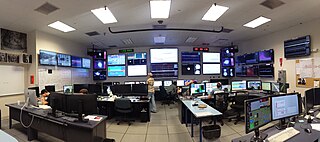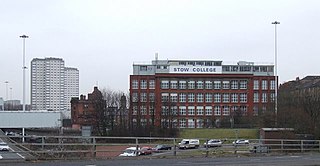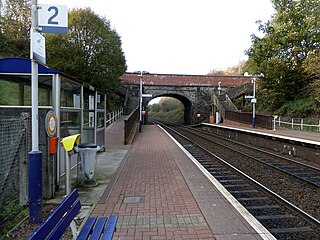Related Research Articles

Glasgow is the most populous city in Scotland and the fourth-most populous city in the United Kingdom, as well as being the 27th largest city by population in Europe. In 2020, it had an estimated metro population of 1,861,315, The city was made a county of itself in 1893, prior to which it had been in the historic county of Lanarkshire. The city now forms the Glasgow City Council area, one of the 32 council areas of Scotland, and is governed by Glasgow City Council. It is situated on the River Clyde in the country's West Central Lowlands.

The Laser Interferometer Gravitational-Wave Observatory (LIGO) is a large-scale physics experiment and observatory designed to detect cosmic gravitational waves and to develop gravitational-wave observations as an astronomical tool. Two large observatories were built in the United States with the aim of detecting gravitational waves by laser interferometry. These observatories use mirrors spaced four kilometers apart which are capable of detecting a change of less than one ten-thousandth the charge diameter of a proton.

The Forth and Clyde Canal is a canal opened in 1790, crossing central Scotland; it provided a route for the seagoing vessels of the day between the Firth of Forth and the Firth of Clyde at the narrowest part of the Scottish Lowlands. This allowed navigation from Edinburgh on the east coast to the port of Glasgow on the west coast. The canal is 35 miles (56 km) long and it runs from the River Carron at Grangemouth to the River Clyde at Bowling, and had an important basin at Port Dundas in Glasgow.

Maryhill is an area in the north-west of the City of Glasgow in Scotland. A former independent burgh and the heart of an eponymous local authority ward, its territory is bisected by Maryhill Road, part of the A81 road which runs for a distance of roughly three miles between Glasgow city centre and the suburban town of Bearsden.
The city of Glasgow, Scotland, has many amenities for a wide range of cultural activities, from curling to opera and from football to art appreciation; it also has a large selection of museums that include those devoted to transport, religion, and modern art. In 2009 Glasgow was awarded the title UNESCO Creative City of Music in recognition of its vibrant live music scene and its distinguished heritage. Glasgow has three major universities, each involved in creative and literary arts, and the city has the largest public reference library in Europe in the form of the Mitchell Library. Scotland's largest newspapers and national television and radio companies are based in the city.

Ruchill is a district in the city of Glasgow, Scotland. It lies within the Canal Ward of north Glasgow in the Ruchill Community Council area between the Maryhill and Possilpark areas of the city. It has traditionally been characterised by a high degree of deprivation and social problems. However, from the late 1990s much of the poorer-quality housing stock has been cleared to be replaced by newly built housing association and owner-occupied homes, improving much of the area's character.

Ronald William Prest Drever was a Scottish experimental physicist. He was a professor emeritus at the California Institute of Technology, co-founded the LIGO project, and was a co-inventor of the Pound–Drever–Hall technique for laser stabilisation, as well as the Hughes–Drever experiment. This work was instrumental in the first detection of gravitational waves in September 2015.

The Forth and Clyde canal pathway runs between the Firth of Forth and the Firth of Clyde and is a 106-kilometre-long (66 mi) footpath and cycleway that runs across Scotland, between Bowling, west of Glasgow, and Lochrin Basin in Edinburgh. The path runs on the towpaths of the Forth & Clyde and Union Canals and is entirely off road. The path is well maintained and its surface is generally good, although there are some stretches particularly between Falkirk and the outskirts of Edinburgh where wet weather leads to muddy conditions unsuitable for road intended bicycles. It is well used by walkers and cyclists, and designated as one of Scotland's Great Trails by NatureScot. It also forms part of the National Cycle Network, being designated as Route 754. Sustrans advises that the path is best followed from the Clyde to the Forth because the prevailing wind is from the south west. Much of the path is also suitable for experienced horseriders, although in some places low bridges, narrow aqueducts and gates may restrict access for horses.
The Lanarkshire and Dumbartonshire Railway was a railway company in Scotland. It was promoted independently but supported by the Caledonian Railway, and it was designed to connect Balloch and Dumbarton with central Glasgow, linking in heavy industry on the north bank of the River Clyde. From Dumbarton to Balloch the line would have closely duplicated an existing railway, and negotiation led to the latter being made jointly operated, and the L&DR terminated immediately east of Dumbarton, trains continuing on the joint section.

The Kelvin Aqueduct is a navigable aqueduct in Glasgow, Scotland, which carries the Forth and Clyde Canal over the River Kelvin.

Stow College was a college in Glasgow in Scotland.
Sir James Hough is a British physicist and an international leader in the search for gravitational waves.
The Glasgow, Dumbarton and Helensburgh Railway was independently sponsored to build along the north of the River Clyde. It opened in 1858, joining with an earlier local line serving Balloch. Both were taken over by the powerful North British Railway in 1865, and for some time the line was the main route in the area. As industry developed other lines were opened to serve it, and the line formed the core of a network in the area.

Gilshochill is located to the north west of Maryhill in the City of Glasgow, Scotland. Immediately north of Maryhill basin and Maryhill locks, it is the district where the Bowling and Port Dundas branches of the Forth and Clyde Canal meet each other, at Stockingfield Junction. Situated on a hill overlooking Glasgow, its highest point sits at an elevation of about 150 metres above sea level. Gilshochill is spread over the area around Sandbank Street, bordering the areas of Cadder and Summerston. It falls under the G20 area postal code. It is served by Gilshochill railway station. A new footbridge connecting the area with Ruchill and providing a better link to Maryhill, was installed at Stockingfield Junction in 2022.

Maryhill is one of the 23 wards of Glasgow City Council. It was created in 2007 as Maryhill/Kelvin, and in that election it returned four council members, using the single transferable vote system. The same boundaries were used in 2012. For the 2017 Glasgow City Council election, the boundaries were changed, the ward substantially decreased in territory and population, was renamed Maryhill and returned three members.
The Kelvin Valley Railway was an independent railway designed to connect Kilsyth, an important mining town in central Scotland, with the railway network. It connected Kilsyth to Kirkintilloch and thence over other railways to the ironworks of Coatbridge, and to Maryhill, connecting onwards to the Queen's Dock at Stobcross.

Stockingfield Junction is a canal junction which lies between Maryhill and Ruchill in Glasgow, Scotland. It opened in 1777, and closed in 1963, followed by restoration and a re-opening in 2022. At first a terminus it formed the junction for the Port Dundas branch off the Forth and Clyde Canal main line from 1777.

Sheila Rowan is a Scottish physicist and academic, who is Professor of Physics and Astronomy at the University of Glasgow in Scotland, and director of its Institute for Gravitational Research since 2009. She is known for her work in advancing the detection of gravitation waves. In 2016, Rowan was appointed the (part-time) Chief Scientific Advisor to the Scottish Government.

Kai Kruse Staats is a filmmaker, science researcher, writer, and entrepreneur.

Maryhill Burgh Halls is a local heritage site located in the Maryhill area of Glasgow, a few miles North-West of Glasgow city centre. Maryhill Burgh Halls was initially opened in 1878 as a municipal building complex, which served as a police station and fire station until the 1970s. The complex fell into disuse and disrepair especially towards the late 20th century, and plans for its demolishment were proposed. However, as a result of local campaigning, the decision was taken to restore the complex and for it to be used as a community resource. Repairs, selective demolition, restoration, and development work took place between 2008 and 2011. The halls re-opened in April 2012.
References
- 1 2 "University of Glasgow - Public Engagement Group in STEMM". University of Glasgow.
- ↑ "Glasgow Science Festival".
- ↑ "Glasgow Science Festival: Weegie Science". The Skinny. 31 May 2012.
- ↑ "Glasgow Science Festival - Events Programme". Glasgow Science Festival. Retrieved 16 July 2013.
- ↑ "About Us". Glasgow Science Festival. Archived from the original on 28 January 2016. Retrieved 21 January 2016.
- ↑ "Silliness and songs as Helen Arney stands up for science in Glasgow". STV News. 10 June 2013.
- ↑ "Comedian Helen Arney talks geeks and nerds". The List. 15 May 2013.
- ↑ "Life Drawing: Under the Skin". Glasgow Science Festival. Archived from the original on 23 June 2013. Retrieved 16 July 2013.
- ↑ "Fun for everyone at Glasgow Science Festival". The Evening Times. 21 May 2013.
- ↑ "Food, Festivals, Scotland". The Skinny. 5 June 2013.
- ↑ "What if Glasgow really had a zombie apocalypse?". The Evening Times. 3 June 2013.
- ↑ "Blast off for the Glasgow Science Festival 2012". University of Glasgow. 28 May 2012.
- ↑ "Science Sunday". West End Festival. Archived from the original on 17 July 2013. Retrieved 16 July 2013.
- ↑ "Event Partners". Glasgow Science Festival. Archived from the original on 21 June 2012. Retrieved 16 July 2013.
- ↑ "School of Life Sciences - Dr Deborah McNeill - Staff Profile". University of Glasgow. Retrieved 16 July 2013.
- ↑ "Step aboard the Clipperton Project's floating lab on the Clyde". STV News. 4 June 2013.
- ↑ "Science sets sail from Glasgow". Scottish Government. 4 June 2013.
- ↑ "In pictures: Glasgow University takes main prize at the Herald Higher Education Awards".
- ↑ "Times Higher Education Awards: Times Higher Education Awards 2017".
- ↑ Stewart, Catriona (3 August 2015). "Chemistry workshops going off with a bang" . Retrieved 20 January 2016.
- ↑ Scottish Waterways Trust (5 February 2015). "Maryhill Schoolchildren Become 'Citizen Scientists' for the Day to Tackle Litter on the Forth & Clyde Canal". Scottish Canals. Retrieved 20 January 2016.
- ↑ "CLAN: Community Led Ambassadors Network (Scottish Government Talking Science Award for 2013-14)". University of Glasgow. Retrieved 20 January 2016.
- ↑ "Glasgow Science Festival: Meet the Team". University of Glasgow.
- ↑ Panto Science. "Panto Science". Panto Science. Retrieved 20 January 2016.
- ↑ "University of Glasgow - University events - Glasgow Science Festival - Events and projects - Projects - Chasing the Waves". Archived from the original on 10 July 2017. Retrieved 2 May 2017.